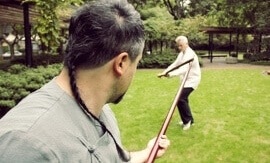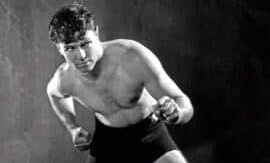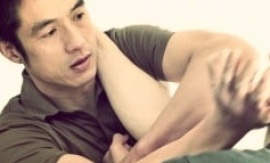
STUDYING UNDER MANY FAMOUS MASTERS OF THE WING TSUN (WT) WORLD IN THE LEUNG TING LINEAGE, SIFU BOEHLIG HAS BECOME AN UP-AND-COMING STAR IN THE WING CHUN WORLD, WITH SCHOOLS IN 15 COUNTRIES AND CREATED HIS OWN METHOD, CALLED BDS (BOEHLIG DEFENCE SYSTEM).
In your opinion, what are the most important attributes to be developed through Wing Chun training?
It comes down to how you structure your training. Generally, I would say:
• The ability to defend yourself with a street-proven system.
• Developing tactile skills, thanks to Chi Sau training, which can help us get to know our bodies much better than we ever would otherwise.
• The ability to deal with our own aggression and the skill to control it.
How have you changed how you approach your Wing Chun, as you’ve gotten older?
It hurts me to see some of my childhood heroes, who were once cherished and praised for their tough fighting abilities, only seem to live off their legacy. The reason for this is they never adapted their Wing Chun to their declining athletic abilities that are bound to come with age.
When I was in my twenties, I was hot-tempered. I learned from a Sifu I considered the best fighter. For me, training was not training if there wasn’t a lip or nose bleeding; in addition, I worked as a bouncer for eight years to get real-life experience (of which I have received my fair share). My Wing Chun training taught me a lot about effective fighting. When I started my training, a punch was just that, a punch. Today, I know what a punch can do. I saw many people fall in real fights, which taught me to underestimate no one.
Nowadays, my Wing Chun credo is that “if a 50-kg girl can apply a technique against a 100-kg guy,” I will teach it. If that’s not the case, then it’s time wasted.
Please explain the meaning of Chi Sau to you. What should the emphasis be while practising it?
There are multiple layers to Chi Sau training:
• Technical Chi Sau: I think of a Sifu teaching a student or two training partners practising a certain sequence as Technical Chi Sau. Here, the practitioners should emphasise correct angles and bite-sized chunks of techniques to get the desired sequence into the system. The partners should use a discussed intensity and pressure, begin slowly, and then gradually increase the speed.
• Pressure Training in Poon Sau: In this training, the focus lies in feeling where the opponent’s pressure gaps are and in making use of these.
• Competitive Chi Sau: Here, anything goes! The goal is to deal with the partner’s attacks at a high speed with varying levels of intensity.
Overall, Chi Sau develops complex sensorimotor actions, such as in double-handed Poon Sau, where both hands must deal with different tasks the whole time. The practitioners seek to maintain contact with their partners, guided to move through paying attention to kinaesthetic and proprioceptive signals. Practitioners develop these “sticky” abilities with extensive training and learn to “read” the directions of their opponents’ motion and respond appropriately, which can help to react according to the opponent’s actions in a real fight scenario.
What do you think makes Wing Chun a successful street fighting system? And how does Chi Sau relate to forms and free fighting?
There are three components:
• Forms by which we learn the techniques we can use in a fight.
• Applications, which teach us how we can make use of these techniques in multiple scenarios.
• Concepts through which we can deal with any situation using our sensorimotor skills.
Some people think Chi Sau is the link between forms and free fighting, but I disagree. Chi Sau is a way to learn better adaptation of Wing Chun principles in a stressful environment. However, it’s not the only link. Sparring training, for example, is vitally important. My Chi Sau may be fine when I play with a partner who follows the same rules as me, but how much of it I can apply in a real fight comes down to proof-testing it in a sparring scenario, where not just the arms are used, but kicks, feints, and other sneak-attacks are the reality.
Still, the most important thing to know about fighting with Wing Chun on the street is that, although your main objective should be to survive the violent situation, you also have a responsibility towards the aggressor. Wing Chun is dangerous and should be used with caution. Therefore, use it efficiently but remain the master of your emotions.
Are you worried that Wing Chun is being gradually watered down?
Not at all. Since I run schools in 15 countries, I have the privilege to meet a lot of Wing Chun practitioners from around the world and have realised, nowadays, our art has many facets. Wing Chun has undergone enormous developments, and it has never been so rich and so poor simultaneously.
There is a multitude of so-called “schools” that hide in some basement where a self-proclaimed Sifu teaches twice per week what he has learned from books and Sifu YouTube. On the other hand, many authentic students of our Grandmasters still teach traditional styles.
Meanwhile, some of my best friends have dedicated their entire lives to studying, teaching and researching Wing Chun full-time, so students who will do research and effort can always find valuable and skilful teachers. Masters who have spent years of sweat, training and research looking at Wing Chun from a different angle may not be watering down the tradition but developing or refining it.
How important is the understanding of structure in teaching Wing Chun?
I’d like to answer with something a Chinese high-profile Wing Tsun master once told me. He said: “ The Chinese way of teaching is chaotic. There are no written curricula, no step-by-step building stones for most of the training sessions.”
Our style, with all its wonderful and ingenious ideas, comes from these origins. Maybe, if we include a little Western teaching methodology, we can mould Wing Chun into something that will avoid quality deficits, as ANY education needs structure! Structure gives the student security he or she is learning correctly and safely, and you, the instructor, a guideline to go back to.
In your many years of teaching, what’s your most memorable moment?
Probably when one of my female students surprised me in class with flowers and a “Thank You” note. It turned out that a guy tried to rape her while she was on the way to class, and she was able to defend herself verbally and physically and to run away.
How would you like to see Wing Chun develop in the modern world?
In comparison with styles such as Karate, Judo and Taekwondo, Wing Chun is still relatively unknown in most countries, and this is something I’d like to see change. I also believe we need more scientific backup from universities to strengthen the appreciation of the art amongst a mainstream crowd. For example, two professors at the University of Stirling in Scotland have just applied for a research study to find out what happens in the brain when a practitioner trains Chi Sau and how kinaesthetic and proprioceptive feedback can enable the practitioner to react with the flow, subconsciously forming the correct answer to the stimuli given. My team and I are partners in crime for them, and hopefully soon, we can publish the results.
One thing most Wing Chun instructors are still painfully lacking is managerial skills. We need big Wing Chun schools with 300, 400 and 500 students starting from four-years-old all the way to retirement age. We have a damn good product, so let’s learn how to market our schools professionally and to make a positive difference in the lives of millions. The potential is there. We just have to take action.



















